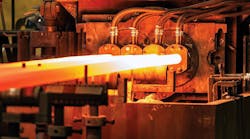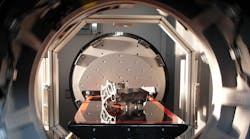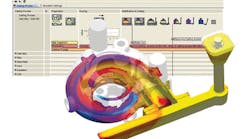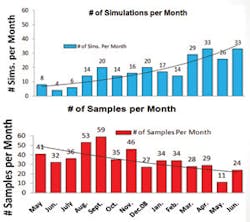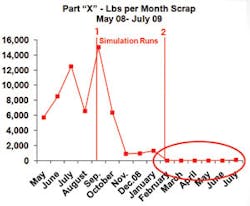Wellsville Foundry Inc. in Ohio is a “a small, specialty foundry,” according to its president, producing ductile, ADI, and CGI casting, mainly for customers and nearby states. Its specialties are heavy-section parts, meaning parts for mining and material handling equipment, and manufacturing machinery of all sorts. Its castings fit projects that require high strength and abrasion-resistance — all of which means its products require precision in design and represent a considerable capital investment.
Like many foundries in that market niche, Wellsville has done well in recent years amid steady demand for new machinery and infrastructure projects that have buoyed its customer base.
But, this is also a highly competitive segment of the metalcastings industry: buyers are able to dictate their terms for product design, quality standards, delivery, and perhaps even cost, so a foundry has to be able to control the production process and variables in order to keep the customer and make the effort profitable.
Wellsville Foundry has found some of its advantage by simulating casting processes. “We make the product in the same process that Jesus would recognize if he were down in the foundry,” according to the company’s president, C.H. Gilmore, “but everything behind the scenes is right up in the 21st Century.”
The general concepts of casting process simulation are not new, and there are various choices available to foundries and diecasters to test pouring, mold filling, and solidification, digitally and visually, without the time, cost, and risk of the actual process. Wellsville Foundry’s choice is MAGMA Foundry Technologies’ MagmaSoft platform, now in its fifth generation, which simulates the entire sequence of casting production, from design through evaluation of results. In addition to process simulation, the MagmaSoft program also has functions for general project management, solid modeling, and interactive capabilities for result evaluation.
Gillmore put his finger on something about metalcasting that stumps outsiders and casual observers: there are some aspects of it that cannot be made simpler or less demanding. It is a hot, loud, caustic activity. It consumes lots of energy and raw materials, and it ties up a lot of capital.
Foundry operators, like Gillmore, know there is more to it than that though. “MagmaSoft gives us the ability to simulate on the computer exactly what's going to happen with the molten metal finds its way into the sand mold, and then, as it cools, it helps us identify where we may have shrinkage defects,” he explained.
“It's also helpful in terms of controlling the velocity of the metal that goes into the mold,” he continued. “If it goes in too fast, you end up blowing sand grains out of the mold and including them in the casting, which is not what you want.”
Gillmore acknowledged using an early version of solidification modeling prior to selecting MagmaSoft, “and it basically just looked at three or four elements in an iron casting process to predict what the result would be.
“But, with MagmaSoft, you don’t assume that everything inside that mold is a uniform temperature, because it isn't. As the material flows across the sand, it's cooling and the other materials coming behind it is hotter, and you can see how the mold is filling, you see some parts are starting to cool. With some of the older programs, you’d just assume that whatever temperature you pour is the temperature that's in there. It pulled its calculations on cooling rates based on that assumption.
“What's good about MagmaSoft, and the newer generation of software, is that they actually follow the fluid flow, and they can tell you a lot of things about what is happening as the mold is filling, in respect of temperatures and velocities, areas where you see a lot of turbulence, which can also create defects,” Gillmore emphasized. “It's like being in there without being burned up.”
In other words, casting process simulation allows Wellsville Foundry, and other metalcasting operations, to test their systems and capabilities without the risk of failure.
Finding New Value
In a wide-ranging interview, Gillmore identified a series of specific gains that Wellsville Foundry has derived by adopting MagmaSoft:
1. “It saves a lot of time and resources on the foundry floor,” Gillmore first noted.
2. “It improves the design of the casting process in the office,” he followed, “so we have a much higher probability of getting the process right the first time on the foundry floor.”
3. Continuing, he then offered “It has saved us from making a lot of scrap in the foundry.”
4. And that point has a corollary in product quality: “It has helped to cut down the number of product rejections,” for Wellsville Foundry, the president confirmed.
5. “It reduces the total cycle time,” he summarized, “from the time we get a request for a casting to the time we deliver it. That gives us a bit of a competitive advantage, as well.”
Gillmore’s experience is that simulation software has brought Wellsville Foundry a greater understand of itself as a metalcasting operation —but equally important is that MagmaSoft has helped Wellsville make its best presentation to casting buyers.
“We had an opportunity where we needed to deliver a very high quality part, one that would withstand X-ray analysis as well as magnetic particle analysis after casting and machining.” Simulating the product development and testing the production process in MagmaSoft made it possible to arrive at such a product. “And that has opened the doors for us in some industries where we wouldn't have been able to even knock on their door,” Gillmore assured.
The RFQ came from a high-profile group that presented its own design for a cast part of an amusement park ride, with a Class 1 safety rating — and they wanted 200 of these.
“We'd been using MagmaSoft for two to three years before they approached us, so we thought we could do it,” he recalled. “And then, they came in with a part that had big variations in wall thicknesses … When you start to have a lot of changes in the cross-sectional areas, it is prone to having defects,” he said.
But, using the simulation suite the Wellsville engineers were able to demonstrate how to produce the difficult part successfully. “It took us about 22 iterations on the one part,” Gillmore noted.
In addition to the product modeling, MagmaSoft revealed metal temperature and mold fill times, as well as chemical variations in the casting process.
“They have a large enough database that they can show you if you have the same foundry conditions but different chemistries, you're going to have different results. That fit in nicely with what we'd been moving toward, having used photospectrometry for a number of years, we could control the chemistry tightly, which would then get us material cost savings.”
Converting the prospective customer’s design into a producible and acceptable casting took about a month of simulation, Gillmore recalled. The MagmaSoft program has been updated since that project, and Wellsville Foundry has improved its data processing capabilities, so the same assignment would surely achieve faster results now, he said.
“I don’t think we would have been able to do the job if we'd had to keep casting and tearing apart our results,” Gillmore assured. “We had to pass X-ray testing, so even if we had cut every casting apart, we'd have only seen the major flaws.
“With this tool, we’re able to look at the casting as if it were an X-ray machine. We can go through it, we can see a defect and slice it at a point exactly where it is in the X, Y, and Z planes.”
This experience also revealed something new about Wellsville Foundry’s customers — and prospective customers. They have started to raise their expectations of quality for the parts they design and order, “akin to aerospace quality requirements,” Gillmore said.
“In the past you could make a casting that looked the same as the one requested, and unless it had major flaws in it, it would probably perform.”
The casting Wellsville Foundry delivered has met the new standards, but as the metalcasting industry adopts nondestructive testing more widely, in order to comply with new quality standards, casting process simulation provides the level of certainty that must follow.
That has implications for staffing and expertise, and with just 20 employees Wellsville Foundry would be challenged to perform, except for the proficiency that MagmaSoft provides.
“We are a small, specialty foundry,” Gillmore concluded. “There are every few like us that have the technical expertise to do this. The big guys don’t have time to do short runs. It would just cost them too much in overhead. So it’s sort of a niche for us to be able to use this tool and produce castings of comparable quality as the great foundries of the world.”







